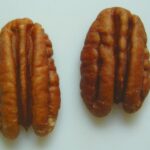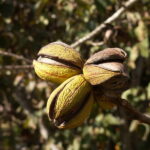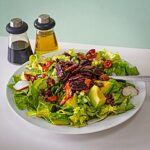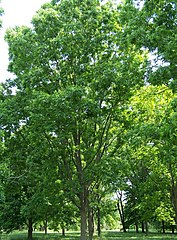

Pecans (carya illinoisensis) are an edible nut most often associated with desserts, particularly pecan pie, an extraganza of added sweetness. [Recipe Below] Pecans are also found in praline candy, cakes, cookies, and candied nuts. But this is misleading association, because, in fact, raw pecans are loaded with healthy monounsaturated fat and fiber, as well as being a good source of calcium, magnesium, potassium, and anti-oxidents. A handful of pecans (about 19 halves) is a mere 200 calories that can be consumed in a salad.


Technically, pecans are a fruit known as a drupe, which is a fruit with a single stone surrounded by a husk. And though we refer to the pecan as a type of nut, it is more correctly a seed produced by a decidous tree that is part of the hickory family.
In the wild, these trees grow near water sources in northern Mexico and the southern United States. The name pecan, which has different pronunciations in each region, comes from a Algonquin word, pecanes, which meaning the shell needed to be cracked with a stone. The same word referred to walnuts and hickory nuts. Spanish explorers called the nut nuez de la arruga, or “wrinkle nut.”

A commercial nut crop requires consistent fruit. However, pecans don’t reliably reproduce for seed – a seed taken from a certain tree can produce a completely different type of pecan from its source. Consequently pecans had no future as a commercial crop until the correct variety could be grafted onto solid stock.

Enter Antoine, a slave living on Oak Alley Plantation in Louisiana who was an expert at grafting trees. In 1846, Antoine produced a consistent variety of pecan with a shell so thin it was called a “paper shell.” With the official name of Centennial Variety, Antoine’s pecan was entered into the 1876 Centennial Exposition in Philadelphia, and won a prize.

During the 1880s pecan orchards began to appear, and in 1886 the first recipe for pecan pie became available. It seems to have been based on a pre-existing recipie for Sugar Pie, sometimes known as Chess Pie. The pie’s popularity coincided with the success of Karo Syrup, which introduced light and dark corn syrup in 1902. In the 1930s, the wife of one of Karo’s sales executives discovered she could make pecan pie with Karo’s lighter corn syrup instead of using molasses or dark syrup.; Karo printed a the recipe on the side of their containers, and the standard pecan pie recipe took off.
There are many variations on the basic pecan pie recipe. The one illustrated in the video below is from Food Wishes and uses the following ingredients:
Enough pie dough for a 9 1/2 inch glass pie dish [Pre-bake crust]; 2 cups pecan halves; 1/2 cup butter (4 oz); 1 cup light brown sugar; 1/2 cup white sugar; 1/2 cup light corn syrup; 1/2 tsp fine salt; 1 tsp vanilla; 1 tbsp bourbon; 2 tbsp milk; 3 tbsp flour; 3 large eggs.
*Bake at 350 F. for about 45 minutes, or until browned and set.
After watching the video, I concluded two things. Pecan pie is, technically, not difficult to make. It is, however, far too time consuming for me. Besides, I’d have to triple my walking time to work off the sugar.
🥧🥧🥧
Illustrations
Carya illinoinensis – Pecan, 1812
Two Pecan Halves by Markus Brunner
In-husk pecan nuts
Avocado-Pecan Salad by FranHogan
Pecan Tree by Bruce Marlin
Oak Alley Plantation by Emily Richardson.
Pecan Pie by Jonathunder
Jaclyn London. “9 Health Benefits of Pecans.” Good Housekeeping. Dec. 6, 2017.

Sandra Wagner-Wright holds the doctoral degree in history and taught women’s and global history at the University of Hawai`i. Sandra travels for her research, most recently to Salem, Massachusetts, the setting of her new Salem Stories series. She also enjoys traveling for new experiences. Recent trips include Antarctica and a river cruise on the Rhine from Amsterdam to Basel.
Sandra particularly likes writing about strong women who make a difference. She lives in Hilo, Hawai`i with her family and writes a blog relating to history, travel, and the idiosyncrasies of life.

